#ceratophyllum demersum
Explore tagged Tumblr posts
Text
Minipond update!
The iris has doubled since two weeks ago, the mare's tail has started peeking out (and it's already going out of the vase... I don't think it needed any fertilizer at all *chuckles I'm in danger meme*), and the water-plantain is forming real leaves.
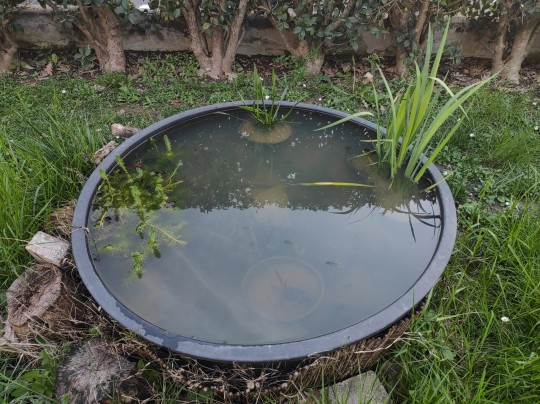

Amongst the submerged ones, the hornwort is doing okay as always – I think it's growing slower than usual thanks to the bigger size of the canadian waterweed and I'm not complaining; the new water lily has lost her biggest leaf to the ice but! is growing three very small ones, and also it needs some more earth in the vase. Fingers crossed for my shady lady. I can't seem to manage to photograph the canadian waterweed that did an awesome work this winter, spreading around a good bit, and even reaching the surface, all of it outside of its vase (duh of course) and which I hope it'll also bloom when the time comes.

All the pics are like this, muddy water and a barely identifiable something. But even if it's still like that, there aren't any algae already anymore (it was FAST), and with time and less rain the water will clear up.
This year will be fun because we'll need to move the pond again since we must do some renovating in the garden. I think I found the right new (new) place but who knows?
#the pondsy chronicles#iris#iris louisiana black gamecock#mestolaccia#alisma plantago aquatica#common water plantain#coda di cavallo acquatica#hippuris vulgaris#common mare's tail#ninfea#nymphaea shady lady#ceratofillo comune#ceratophyllum demersum#hornwort#coontail#peste d'acqua#elodea canadensis#canadian waterweed
13 notes
·
View notes
Text
Class Round 1: Nymphaeales vs Ceratophyllales

Water Lilies vs Aquarium Plants
Nymphaeales: A basal clade of Magnoliophyta that contains the water lily family, and other aquatic plants with prominent flowers. Water lilies with larger flowers and more complex parts are pollinated by beetles -- they were initially believed to be plants that evolved earlier, but while Nymphaeales as a whole did diverge early, the ones with more flower parts did not diverge earlier than the ones with fewer flower parts. Water lilies were used as an indicator of water cleanliness in the Maya civilization, were a symbol of the Maya elite, and were likely used in a religious context to induce altered states of consciousness.
Ceratophyllales: Core Magnoliophytes that are very closely related to the eudicots. These aquatic plants are found all over the world, and are known as coontails or hornworts (though they are not related to the non-vascular hornworts from the phylum battle.) Ceratophyllum demersum is sold as an aquarium plant, and is considered invasive in Tasmania and New Zealand, where it has been known to interfere with hydroelectric power plants.
#before I started this tournament I would have assumed#that ceratophyllales wouldn't get many votes#but given the apparent deep and widespread love#of moss-like plants#who knows really?#nymphaeales#ceratophyllales#plant taxonomy showdown#battle of the plants#class round 1#class#plant bracket#tumblr bracket#bracket tournament#poll bracket
37 notes
·
View notes
Text
Native Plants I’ve Actually Seen Growing Wild in Southern Ontario
Acer saccharinum (silver maple) --along the sides of highways
Acer saccharum (sugar maple) --GTA ravines
Achillea millefolia (yarrow) --GTA ravines
Allium schoenoprasum (wild chives) --GTA ravines, Ridgetown
Allium tricoccum (ramps) --Niagara region escarpments
Amaranthus retroflexus (redroot amaranth) --fallow areas in the GTA
Ambrosia artemisiifolia (ragweed) --fallow areas in the GTA
Ambrosia trifida (giant ragweed) --parks in the GTA
Amelanchier spp. (saskatoon/serviceberry) --GTA ravines
Arisaema triphyllum (Jack-in-the-pulpit) --GTA ravines
Aronia melanocarpa (black chokeberry) --ravines and parks in the GTA
Asarum canadense (Canada ginger) --GTA ravines
Asclepias syriaca (common milkweed) --fallow areas, ravines, and parks throughout southern Ontario from Windsor to GTA
Asplenium trichomanes (maidenhair spleenwort) --Niagara region escarpments
Betula spp. (birch) --ravines and parks throughout southern Ontario from Windsor to GTA
Bidens spp. (beggar ticks) --GTA ravines
Caulophyllum thalictroides (blue cohosh) --GTA parks
Ceratophyllum demersum (hornwort) --GTA ravines (native in freshwater across the globe anyway)
Circaea lutetiana (enchanter’s nightshade) --fallow areas in the GTA
Commelina spp. (dayflower) --fallow areas in Windsor
Cornus alternifolia (Pagoda dogwood) --GTA wooded areas
Cornus sericea (red osier dogwood) --GTA ravines and in Windsor riverside parks
Crataegus spp. (hawthorn) --GTA ravines and parks
Echinocystis lobata (wild prickly cucumber) --GTA ravines
Elaeagnus commutata (silverberry) --GTA parks and fallow areas
Epilobium ciliatum (fringed willowherb) --fallow areas in the GTA
Equisetum spp. (horsetail/scouring rush) --GTA ravines and fallow areas
Erigeron spp. (fleabane) --GTA parks and fallow areas, Ridgetown
Erythronium americanum (trout lily) --GTA ravines and parks
Eutrochium maculatum (Joe-Pye weed) --GTA parks
Fragaria virginiana (wild strawberry) --fallow areas in the GTA
Geranium maculatum (wild geranium) --Windsor green spaces
Geranium robertianum (herb robert) --Windsor green spaces
Geum aleppicum (yellow avens) --GTA fallow areas
Geum canadense (white avens) --GTA fallow areas
Geum macrophyllum (large-leaved avens) --GTA fallow areas
Gymnocladus dioicus (Kentucky coffee tree) --GTA ravines
Helianthus spp. (sunflower) --GTA fallow areas and parks
Heracleum maximum (cow parsnip) --GTA ravines
Hordeum jubatum (foxtail barley) --GTA fallow areas
Humulus lupulus (hops) --GTA ravines
Hydrophyllum virginianum (Virginia waterleaf) --GTA ravines
Impatiens capensis (jewelweed) --GTA ravines and in Windsor riverside parks
Juglans nigra (black walnut) --GTA ravines
Lactuca canadensis (Canadian lettuce) --GTA fallow areas
Lilium michiganense (Michigan lily) --GTA ravines
Lupinus perennis (sundial lupine) --GTA parks
Maianthemum canadense (Canada mayflower) --GTA ravines
Maianthemum racemosum (starry false solomon’s seal) --GTA ravines and parks
Maianthemum stellatum (starry false solomon’s seal) --GTA ravines
Matteuccia struthiopteris (ostrich fern) --GTA ravines
Monarda fistulosa (wild bergamot) --GTA ravines and parks
Morus rubra (red mulberry) --fallow areas in Windsor, GTA parks
Myosotis laxa (smallflower forget-me-not) --GTA fallow areas
Oenothera biennis (evening primrose) --GTA fallow areas
Onoclea sensibilis (sensitive fern) --GTA ravines
Oxalis stricta (yellow wood sorrel) --fallow areas and ravines throughout southern Ontario from Windsor to GTA
Parietaria pensylvanica (Pennsylvania pellitory) --GTA fallow areas
Parthenocissus quinquefolia (Virginia creeper) --Windsor fallow areas and GTA ravines and parks
Persicaria lapathifolia (curlytop smartweed) --GTA fallow areas
Podophyllum peltatum (mayapple) --GTA ravines and parks
Portulaca oleracea (purslane) --fallow areas throughout southern Ontario from Windsor to GTA (native globally anyway)
Potentilla norvejica monspeliensis (ternate-leaved cinquefoil) --GTA fallow areas
Prunella vulgaris (selfheal) --fallow areas and ravines throughout southern Ontario from Windsor to GTA
Prunus virginiana (chokecherry) --Windsor fallow areas, GTA ravines and parks, Niagara region escarpments
Pteridium aquilinum latiusculum (western bracken fern) --GTA parks
Quercus spp. (oak) --wooded areas throughout southern Ontario from Windsor to GTA
Rhus typhina (staghorn sumac) --parks and fallow areas throughout southern Ontario from Windsor to Collingwood
Ribes spp. (currants) --GTA ravines and parks
Ribes spp. (gooseberries) --GTA ravines
Robinia pseudoacacia (black locust) --GTA ravines and parks
Rosa spp. (roses) --GTA ravines, parks, and fallow areas
Rubus occidentalis (black raspberry) --ravines, parks, and fallow areas in Hamilton and GTA
Rubus odoratus (purple-flowered raspberry) --GTA ravines and parks
Rubus strigosus (American red raspberry) --GTA parks
Rudbeckia hirta (black-eyed susan) --GTA parks
Salix spp. (willow) --GTA ravines
Sambucus canadensis (common elderberry) --Windsor riverside parks, GTA ravines
Sambucus racemosa (red elderberry) --GTA ravines and parks
Smilax spp. (greenbrier) --GTA parks
Solidago canadensis (Canada goldenrod) --parks and fallow areas throughout southern Ontario from Windsor to GTA
Sorbus spp. (mountain ash) --GTA ravines and parks
Streptopus spp. (twistedstalk) --GTA parks
Symphoricarpos spp. (snowberry) --GTA parks
Symphyotrichum ericoides (heath aster) --fallow areas throughout southern Ontario from Windsor to GTA
Symphyotrichum novae-angliae (New England aster) --fallow areas throughout southern Ontario from Windsor to GTA
Symplocarpus foetidus (skunk cabbage) --GTA parks
Tilia spp. (linden) --GTA ravines
Trillium grandiflorum (white trillium) --parks throughout southern Ontario from Windsor to GTA
Tsuga canadensis (eastern hemlock) --GTA parks
Typha latifolia (broad-leaved cattail) --marshes in Essex county and GTA
Urtica gracilis (slender nettle) --GTA ravines
Uvularia spp. (bellwort) --streams in Windsor green spaces
Verbena hastata (blue vervain) --GTA ravines
Viburnum lentago (nannyberry) --GTA parks and Ridgetown ravine
Viburnum trilobum (highbush cranberry) --Ridgetown
Viola sororia (wood violet) --fallow areas and wooded areas throughout southern Ontario from Windsor to GTA
Vitis riparia (riverbank grape) --GTA fallow areas, ravines, and parks
Waldsteinia fragarioides (barren strawberry) --GTA ravines and parks
Xanthium strumarium canadense (Canada cocklebur) --GTA parks and fallow areas
I’ve likely seen many others and just couldn’t identify them, but there are a lot I’ve never seen growing wild. What I’m hoping is that some of the native species I have in my garden will make their way to the nearby ravine. If I get around to it, though, I might just take a walk with some Asclepias incarnata (swamp milkweed) seeds in the fall. They certainly seem to successfully germinate in my garden whether I want them to or not (don’t have space for them to go crazy). Can’t see why they wouldn’t in a natural swamp area.
#text post#long text post#native plants of Ontario#native plants of North America#wild native plants
10 notes
·
View notes
Text
Discovery of Carasobarbus Sublimus in Al-Diwaniya River, Iraq

Abstract
During a fish survey from 2016 to 2017, we captured 83 specimens of the cyprinid fish, Carasobarbus sublimus from the Al-Diwaniya River, Middle Euphrates, Iraq. This is the first report of the occurrence of this species in this locality. Fish were captured by gill nets and electro-fishing equipment. Twenty two morphometric and eleven meristic measurements were applied to describe the species. The range of total length in the present specimens (130.4-250.1mm) is larger than the range quoted for C. sublimus. The indices characters to standard length (SL) varied from 7.4 % to 121.0 %, and the head characters to head length (HL) from 27.4% to 93.2%. The growth rate between body characters and SL varied from 0.085 to 1.118 and between head characters and HL from 0.210 to 1.091.The numbers of scales in lateral line and around the least circumference of the caudal peduncle are 27-29 and 12, respectively. The biometric data were successful in identifying of C. sublimus and confirm the presence of the species in the Al-Diwaniya River. This is the second record of the species in the Iraqi freshwaters. Based on this finding, the case would be interesting and open to discussion about the distributions of C. sublimus in the Tigris-Euphrates basin.

Introduction
According to Borkenhagen and Krupp (2013), the cyprinid genus Carasobarbus Karaman, 1971 (the himri) belong to the family Cyprinidae, subfamily Barbinae are distributed across southwest Asia and northwest Africa. They occur in all major river systems of the Levant, Mesopotamia, southern Iran, western and south-western Arabian Peninsula and in northern Morocco.
Also, Borkenhagen and Krupp (2013) revised and expanded Karaman’s (1971) diagnosis of the genus that now contains the nine following species: Carasobarbus apoensis, C. canis, C. chantrei, C. exulatus, C. fritschii, C. harterti, C. kosswigi, C. luteus and C. sublimus.
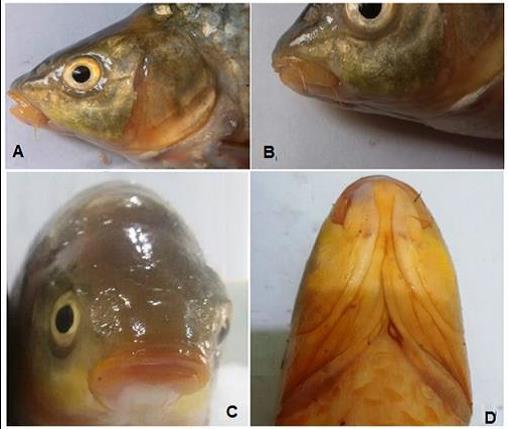
Three species from the genus, C. luteus, C. kosswigi and C. sublimus have been reported from Iranian waters (Borkenhagen and Krupp, 2013) and C. chantrei, C. kosswigi and C. luteus from Turkish waters (Çiçek et al., 2015), while C. luteus, C. kosswigi and C. sublimes were found in Iraqi waters (Coad, 2010; Mohamed et al., 2017).
C. sublimus was first described and reported by Coad and Najafpour in 1997 from Khuzestan waters, southwestern Iran. C. sublimus formerly placed in the genus Kosswigobarbus Berg, 1916, but Borkenhagen et al. (2011) placed this species in Carasobarbus.
Coad and Najafpour (1997) and Esmaeil et al. (2006) have rectified the species by comparing it with C. kosswigi and C. luteus on the basis of their morphology in Iran, while, Mohamed et al. (2017) described and compared C. sublimus obtained from the Shatt Al-Arab River for the first time in Iraq with C. luteus in Iraqi waters.
During the ichthyofauna survey for the Al-Diwania River (a branch from the Euphrates River, middle of Iraq) during November 2016 - October 2017, several specimens of cyprinid fish, C. sublimus have been caught for the first time from south the Daghghara barrier on this river.
The predominant vegetations on the both banks of this locality were reed, Phragmites australis and cattail, Typha domingensis, whereas hornwort, Ceratophyllum demersum was dominant in the deeper areas.
The water temperature of the river varied from 10.2oC in March to 32.8oC in August, dissolved oxygen fluctuated from 5.0mg/l in August to 9.6mg/l cm in February, salinity values ranged from 0.55‰ in April to 0.79‰ in October (Mohamed and Al-Jubouri, 2017).
So, the purpose of this paper is to describe the morphometric and meristic characters of C. sublimus for the first time in the middle of Iraq. Examined specimens had been placed in the fish collection of the Department of Pathology, College of Veterinary Medicine, Al-Qasim Green University, Iraq.
Source Occurrence of cyprinid fish, Carasobarbus sublimus in the Al-Diwaniya River, Middle Euphrates, Iraq
2 notes
·
View notes
Text
The Serene Embrace of Lake Santa Fe: A Florida Gem

A Tapestry of Nature: Ecology and Biodiversity
Lake Santa Fe is more than just a picturesque body of water; it’s a thriving ecosystem teeming with life. The lake’s clear, slightly tannic water, stained by natural vegetation, provides an ideal habitat for a diverse array of flora and fauna.
Aquatic Vegetation: The lake’s shallows are adorned with a lush tapestry of aquatic plants, including eelgrass (Vallisneria americana), coontail (Ceratophyllum demersum), and various species of pondweed. These plants not only provide vital oxygen and shelter for aquatic animals but also play a critical role in maintaining water clarity and nutrient balance.
Fish Populations: Lake Santa Fe is a haven for anglers, boasting a healthy population of largemouth bass, speckled perch (black crappie), bluegill, and catfish. The lake’s diverse habitats, ranging from submerged vegetation to open water, support a thriving fish community, making it a popular destination for recreational fishing.
Wildlife Encounters: Beyond the aquatic realm, Lake Santa Fe and its surrounding shoreline provide habitat for a variety of wildlife. Birdwatchers will delight in spotting ospreys, bald eagles, herons, egrets, and a plethora of waterfowl. Alligators, turtles, and various mammals, including otters and raccoons, also call the lake and its environs home.
Springs and Hydrology: Lake Santa Fe is a “karst window” lake, meaning it is fed by and connected to the Floridan Aquifer. Springs within the lake and along its edges contribute to its water volume and quality. The lake’s hydrology is complex, with interactions between surface water and groundwater playing a crucial role in its overall health.
The lake’s ecological integrity is a testament to the area’s commitment to conservation. Efforts to protect water quality, manage invasive species, and preserve natural habitats are ongoing, ensuring that Lake Santa Fe remains a thriving ecosystem for generations to come.
Read more
Maui Itinerary
Things to do in Marathon Florida
Alligator & Wildlife Discovery Center
3 Days in NYC Itinerary
Discover Mount Tapochau
the Last Japanese Command Post
Things to Do at Lake Casitas
A Playground for All: Recreation and Leisure
Lake Santa Fe offers a plethora of recreational opportunities, catering to a wide range of interests and abilities.
Boating and Water Sports: The lake’s expansive surface provides ample space for boating, kayaking, canoeing, and paddleboarding. Whether you’re seeking a leisurely paddle along the shoreline or an exhilarating ride on a powerboat, Lake Santa Fe has something for everyone.
Fishing: As mentioned earlier, the lake’s abundant fish populations make it a premier fishing destination. Anglers can cast their lines from boats, docks, or the shoreline, targeting a variety of species.
Swimming and Sunbathing: The lake’s clear water and sandy beaches provide ideal conditions for swimming and sunbathing. Several public access points and parks offer designated swimming areas and picnic facilities.
Wildlife Viewing and Photography: Nature enthusiasts will find ample opportunities for wildlife viewing and photography. The lake’s diverse habitats and abundant wildlife provide a rich tapestry of natural beauty to capture.
Hiking and Biking: Surrounding the lake are various trails and parks, offering opportunities for hiking and biking. These trails provide access to scenic overlooks, nature preserves, and other points of interest.
Community Events: Lake Santa Fe is a focal point for community events, including fishing tournaments, boat parades, and festivals. These events bring residents and visitors together, fostering a sense of community and celebration.
Whether you’re seeking adventure, relaxation, or simply a connection with nature, Lake Santa Fe offers a diverse range of recreational opportunities to enjoy.
Echoes of the Past: History and Heritage
Lake Santa Fe’s history is as rich and diverse as its natural beauty.
Native American Heritage: The Timucuan people, who inhabited the region for centuries, were the first to recognize the lake’s importance. They relied on the lake for sustenance, transportation, and spiritual connection. Archaeological evidence suggests that the Timucuan people established settlements along the lake’s shores, leaving behind a legacy of cultural heritage.
Early European Settlement: Spanish explorers arrived in the region in the 16th century, encountering the Timucuan people and documenting the lake’s existence. Later, during the 19th century, American settlers began to establish communities around the lake, drawn by its fertile land and abundant resources.
Steamboat Era: In the late 19th and early 20th centuries, steamboats plied the waters of Lake Santa Fe, transporting passengers and goods between communities. This era marked a period of economic growth and development for the region.
Growth and Development: As transportation infrastructure improved, Lake Santa Fe became increasingly accessible, attracting residents and visitors from across the state. The lake’s natural beauty and recreational opportunities contributed to its popularity as a destination for tourism and recreation.
Conservation Efforts: Recognizing the importance of preserving Lake Santa Fe’s natural resources, local communities and organizations have worked tirelessly to protect the lake’s water quality, manage invasive species, and preserve natural habitats. These efforts have ensured that Lake Santa Fe remains a pristine and vibrant ecosystem for future generations.
The lake’s history is interwoven with the stories of the people who have lived and worked on its shores, leaving behind a rich tapestry of cultural heritage.
Challenges and Conservation: Protecting a Precious Resource
Like many natural resources, Lake Santa Fe faces a number of challenges, including:
Water Quality: Maintaining water quality is a paramount concern. Runoff from urban and agricultural areas can introduce pollutants into the lake, impacting its ecological health.
Invasive Species: Invasive plants and animals, such as hydrilla and tilapia, can disrupt the lake’s ecosystem, displacing native species and altering habitats.
Development Pressures: Increasing development around the lake can lead to habitat loss, increased runoff, and other environmental impacts.
Climate Change: Rising temperatures, changes in rainfall patterns, and sea-level rise can impact the lake’s hydrology and ecosystem.

The Enduring Appeal of Lake Santa Fe
Lake Santa Fe’s enduring appeal lies in its ability to offer a tranquil escape from the pressures of modern life. Its pristine waters, diverse ecosystems, and rich history create a unique and captivating experience for all who visit.
Whether you’re seeking adventure, relaxation, or simply a connection with nature, Lake Santa Fe provides a sanctuary of peace and beauty. Its shimmering waters reflect the sky, mirroring the tranquility that pervades this hidden gem of Florida. The gentle lapping of waves against the shore, the calls of birds echoing across the water, and the rustling of leaves in the surrounding forests create a symphony of nature that soothes the soul.
Lake Santa Fe is more than just a lake; it’s a living, breathing ecosystem, a testament to the power and beauty of nature. It’s a place where memories are made, where friendships are forged, and where the spirit is renewed. As we navigate the complexities of the 21st century, places like Lake Santa Fe remind us of the importance of preserving our natural heritage for generations to come. It’s a place to be treasured, protected and enjoyed.
Here are some FAQs about Lake Santa Fe:
Q: Where is Lake Santa Fe located?
A: In Alachua County, Florida.
Q: How large is Lake Santa Fe?
A: Approximately 5,900 acres.
Q: What types of fish can be found in Lake Santa Fe?
A: Largemouth bass, speckled perch (black crappie), bluegill, and catfish.
Q: Is Lake Santa Fe good for boating?
A: Yes, it’s popular for boating, kayaking, canoeing, and paddleboarding.
Q: Can you swim in Lake Santa Fe?
A: Yes, there are designated swimming areas and sandy beaches.
Q: Are there alligators in Lake Santa Fe?
A: Yes, alligators are part of the lake’s ecosystem.
Q: What kind of wildlife can be seen at Lake Santa Fe?
A: Ospreys, bald eagles, herons, egrets, otters, raccoons, and various turtles.
Q: Is fishing allowed on Lake Santa Fe?
A: Yes, recreational fishing is popular.
Q: Are there public access points to Lake Santa Fe?
A: Yes, several public access points and parks are available.
Q: Is Lake Santa Fe fed by springs?
A: Yes, it’s a “karst window” lake connected to the Floridan Aquifer, with springs contributing to its water.
Q: What is the water quality like at Lake Santa Fe?
A: The water is generally clear and slightly tannic, but ongoing conservation efforts address potential pollution.
#LakeSantaFe#Lakesantafemap#Lakesantafecamping#Lakesantafefishing#FloridaLakes#AlachuaCounty#FloridaNature#ExploreFlorida#ItineraryPlans
0 notes
Text
Hornwort - Ceratophyllum demersum | Bramhaputra Ruver Creek | Assam - India | Habitat, Biotope, Ecosystem, Natural
Call : +917997101120 | Whatsapp : https://wa.me/917997101120 | Website : https://igbokan.com
#Hornwort #RigidHornwort #Coontail #Ceratophyllumdemersum
#Bharadwaz #Habitat #Biotope #Ecosystem #Natural
#IgbokanHabitats #Igbokan
#Fish #Snail #Shrimp #Plant #Animal
About Igbokan Habitats :
A slice of natural habitat that connects you with nature. A habitat is the natural environment where an organism thrives. Keeping an organism in its native setting is both scientific and enjoyable. We specialize in the installation and maintenance of natural habitats.
0 notes
Text
マツモ栽培のコツ【水草】【飼育】【増やし方】
マツモ(Ceratophyllum demersum)は、初心者にも扱いやすい水草の一つです。その飼育方法について、以下のポイントを押さえておくと良いでしょう。 飼育環境 水質 pH: 6.5~7.5が適しています。 水温:…
View On WordPress
0 notes
Text

Tilki Kuyruğu Bitkisi (Ceratophyllum Demersum) Tilki kuyruğu bitkisi, hızlı büyüyen bir türdür. Suda çiçek açar. Doğada genellikle bataklık alanlarda, göllerde ve derelerde yaşar. Yavaş akan ve durgun suları sever. Anavatanı Kuzey Amerika’dır. İstilacı bir tür olduğunu söylemek yanlış olmaz. Bakımı oldukça kolay bir türdür. Lowtech bitkiler arasında popülerdir. Geniş sıcaklık aralığında yaşam gösterebilir. Adapte olma hızı oldukça yüksektir. Hızlı büyüyen bir tür olduğu için bitkili akvaryum türlerinde oluşan nitratı azaltmak adına da kullanılır. Karma akvaryumlarda yavruların korunmasını sağlayan bir türdür. Su üstünde de kullanılabilir. Su üstünde serbest bırakıldığında yavruları, yetişkin balıklardan korur. Yeni kurulmuş veya su kalitesi sorunu yaşayan akvaryum için çokça tercih edilir. Su …
0 notes
Text
A Start - Planted Tank Day 1


After about a month of preparation and research I have assembled my very first planted tank! Already I have learned things I could have done better, and will do better in the future.
The plants are Lobelia cardinalis, Bacopa monnieri (moneywort), Ceratophyllum demersum (hornwort), Nyphaea stellata (dwarf aquarium lily), Hygrophila corymbosa (temple plant), Salvinia minima (water spangles, and I suspect guilty of harboring the snail), Sagittaria subuluta ( narrow leaf sagittaria), Hemianthus Micranthemoides (pearlweed), java moss, a mystery cryptocoryne, and a mystery sword plant. The tank is a bit sparse right now, but hopefully will fill out more as the plants grow and propagate.
1 note
·
View note
Text
Guide to Choosing and Planting Aquarium Plants

Creating a vibrant and thriving aquatic ecosystem within your fish tank involves more than just choosing the right fish species. It also entails selecting the perfect aquatic plants. These green companions not only enhance your tank's aesthetics but also contribute to its overall health and balance. In this comprehensive guide, we'll explore the world of aquarium plants, helping you make informed choices and providing essential tips for maintaining a harmonious and beautiful underwater world. Plus, we'll delve into the specifics of how to plant Anubias nana , Anubias Nana, to ensure your aquatic landscape thrives.
Why Include Plants in Your Fish Tank?
Before we delve into the types of plants suitable for your fish tank, it's essential to understand why plants are an essential addition to your aquatic setup:
Aesthetic Appeal: Aquarium plants add color, texture, and depth to your fish tank, transforming it into a visually captivating aquatic landscape.
Water Quality: Plants play a vital role in maintaining water quality by absorbing excess nutrients and helping to control algae growth. They act as natural filters, reducing the need for frequent water changes.
Oxygen Production: Through photosynthesis, aquatic plants release oxygen into the water, creating a healthier environment for your fish. This oxygenation is particularly crucial in densely stocked tanks.
Shelter and Security: Plants provide hiding spots and shelter for fish, reducing stress and aggression among tank inhabitants.
Choosing the Right Plants for Your Fish Tank
When it comes to selecting plants for your fish tank, several factors come into play:
Lighting: Different plants have varying lighting requirements. Consider the intensity and duration of your tank's lighting to ensure your chosen plants will thrive.
Tank Size: Some plants are better suited for smaller tanks, while others are ideal for larger setups. Be mindful of the available space and select plants accordingly.
Compatibility: Ensure that the plants you choose are compatible with your fish species. Some fish may nibble on plants, so select species that can withstand occasional grazing.
Maintenance: Consider the level of care and maintenance required for each plant. Some are low-maintenance and suitable for beginners, while others may demand more attention.
Popular Plants for Your Fish Tank
Here's a list of popular aquatic plants that can thrive in various tank setups:
Java Fern (Microsorum pteropus): Known for its hardiness and low-light tolerance, Java Fern is an excellent choice for beginners. It adds a lush, green backdrop to your tank.
Anubias (Anubias spp.): Anubias plants are known for their adaptability to different lighting conditions. They are great for attaching to rocks and driftwood, creating a captivating underwater landscape.
Amazon Sword (Echinodorus spp.): With their broad leaves, Amazon Swords make a stunning centerpiece in larger tanks. They thrive in nutrient-rich substrates and require moderate lighting.
Dwarf Hairgrass (Eleocharis parvula): If you're aiming for a lush carpet of green, Dwarf Hairgrass is an excellent choice. It requires moderate to high lighting and a nutrient-rich substrate.
Hornwort (Ceratophyllum demersum): Hornwort is a floating plant that provides excellent oxygenation and serves as a refuge for fry (baby fish). It's incredibly easy to care for.
Cryptocoryne (Cryptocoryne spp.): Crypts come in various sizes and colors, making them a versatile choice. They do well in low to moderate lighting conditions.
Java Moss (Taxiphyllum barbieri): Java Moss is a versatile and hardy moss that can be attached to driftwood or rocks. It provides excellent cover for fish and fry.
Water Wisteria (Hygrophila difformis): Water Wisteria is a fast-growing plant that can help control algae by outcompeting it for nutrients. It's suitable for beginners and thrives in moderate lighting.
How to Plant Anubias Nana
Anubias Nana is a versatile and visually appealing aquarium plant. Here's how to plant it in your tank:
Preparation: Start by preparing your Anubias Nana. Gently remove it from its pot and rinse off any excess substrate to expose the plant's rhizome, which is the thick, horizontal stem from which the roots and leaves grow.
Choosing a Location: Anubias Nana can be attached to hardscape elements like rocks or driftwood. Decide on the desired location within your tank.
Attachment: Use fishing line or aquarium-safe adhesive to secure the Anubias Nana to the chosen hardscape element. Be sure not to bury the rhizome; it should be exposed. This prevents rotting and ensures the plant's health.
Placement: Carefully place the hardscape element with the attached Anubias Nana into your tank's substrate. Ensure it is secure and won't topple over.
Lighting and Care: Provide the appropriate lighting for Anubias Nana, which is typically low to moderate. Ensure it receives proper care, including fertilization and regular pruning, to maintain its health and appearance.
Planting and Maintenance Tips
Once you've selected your plants and, in this case, learned how to plant Anubias Nana, here are some essential tips for planting and maintaining them in your fish tank:
Planting: Gently plant the roots or rhizomes of the plants into the substrate, being careful not to bury them too deeply. Some plants, like Java Fern and Anubias, should not be buried at all but instead attached to hardscape elements.
Lighting: Ensure your tank's lighting matches the requirements of the plants you've chosen. Invest in a timer to maintain a consistent light schedule.
Fertilization: Consider using liquid or substrate fertilizers to provide essential nutrients to your plants, especially in tanks with inert substrates.
Pruning: Regularly trim and prune your plants to control their growth and prevent overcrowding. This helps maintain water circulation and prevents shaded areas where algae can thrive.
Algae Control: Keep an eye on algae growth and take measures to control it. Algae can compete with your plants for nutrients and light.
Water Changes: Perform regular water changes to maintain water quality. This helps remove excess nutrients and waste that can accumulate in the tank.
In Conclusion
Selecting and planting the right plants for your fish tank is a crucial step in creating a healthy and visually appealing aquatic environment. Whether you're a beginner or an experienced aquarist, there are aquatic plants suitable for your tank's size, lighting, and fish species. By carefully choosing and maintaining your plants, you can enjoy the beauty of a thriving underwater landscape while providing a healthy and comfortable habitat for your fish. Plus, learning how to plant Anubias Nana adds another layer of expertise to your aquascaping skills, enhancing the overall beauty of your aquatic haven.
ALSO VISIT : Anubias Nana Care Guide for Beginners
Aquascaping with Anubias Nana
BEST VERSATILE AQUATIC PLANT FOR YOUR FISH TANK
Anubias Nana Planting 101: A Beginner's Guide to Aquatic Flora
0 notes
Text
Now it's raining but yesterday and this morning was sunny and so two flowers of the waterlilies blossomed!!
Yesterday: pink just open, white only poking out of the water


Today: pink fully open and white! not only completely out of the water but!! already opening!!! Would you look at that!


Next: the pondsy in the sun and another little flower growinggg alreadyyy


Bonus pics: soft hornwort with little waterlily leaves + hornwort and a snailsie + how big the leaves are becoming (I don't think they ever reached this size before)



All things going well, even if the spring repotting hasn't happened yet (next week, surely, as I've been telling myself for, uhm, A While. Life's been a bitch!!)
Also, it's basically invisible but I managed to capture one of the various lizards going around the pondsy! It's... there, on the rock in the middle, for only four seconds. Hey, better than nothing!
Seeing the plants growing and seeing all the flowers blossoming it's truly incredible and magical, makes me so emotional every time. And now a lot of birds go there too to drink even in winter time <3 not only the lizards and the bugs in the summer <3 I'm so glad I did this project, even if it's beyond my current physical capabilities 🥹
Happy may first to everyone! Until next time :) 🦎
Score: pink water lily 1, white waterlily 0
#cmonnnnn i really really need to plant the new plants poor babies#the pondsy chronicles#water lily#nymphaea#common water plantain#alisma plantago aquatica#iris#iris louisiana#happy may first#happy international workers day#ninfea#mestolaccia#ceratofillo comune#ceratophyllum demersum#hornwort
7 notes
·
View notes
Text
Class Bracket

Class bracket: Left side top to bottom: Eudicots, Amborellales, Magnoliids, Austrobaileyales.
Right side, top to bottom: Monocots, Chloranthales, Nymphaeales, Ceratophyllales.
Photo ID's: cherry blossoms for Eudicots, Amborella trichopoda (a plant with small white flowers) for Amborellales, a magnolia for Magnoliids, star anise pods for Austrobaileyales, sprouting onion bulbs for Monocots, Sarcandra glabra (a leafy shrub with small red berries) for Chloranthales, hot pink water lillies for Nymphaeales, and Ceratophyllum demersum (a fluffy looking aquatic plant) for Ceratophyllales.
26 notes
·
View notes
Photo
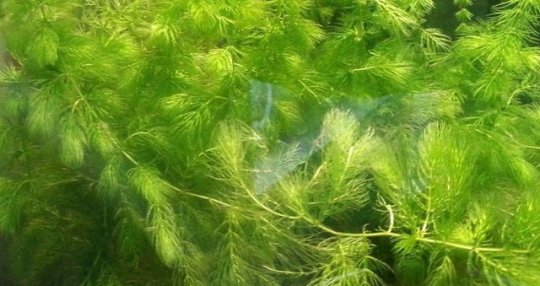
Il Ceratophyllum Demersum nell’Acquario degli Avannotti
Avete da poco attivato il vostro acquario? Magari avete inserito dei Lebistes, che danno colore e movimento, e subito vi siete accorti che le femmine sono gravide e pronte a sfornare tanti simpatici avannotti. Ma come faranno a sopravvivere in un acquario di comunità? Magari con predatori pronti a gustarsi un’ottimo sushi appena nato. Ebbene ecco un buon motivo per cui il Ceratophyllum Demersum nell’acquario non dovrebbe mai mancare, soprattutto se ci sono avannotti.
Leggi di più.
0 notes
Text
Ceratophyllum demersum
This aquarium plant consists of long, fairly brittle stems and very thin leaves that can reach 4 to 5 cm. Plant very fast growth it should be placed in the center or the bottom of the tank.
Because of this rapid growth, it is considered a quality ally in the fight against algae. It absorbs a lot of nitrates to grow and also releases a substance that is toxic to algae. But nothing is shown…
View On WordPress
0 notes
Photo

Ceratophyllum Demersum - Hornwort
#hornwort#ceratophyllum demersum#plants#freshwater aquarium#freshwater fish tanks#freshwater plants#fishblr#fish
12 notes
·
View notes
Text
Before and after the haircut! It was a tad, erm, overgrown maybe? *nervous chuckle*

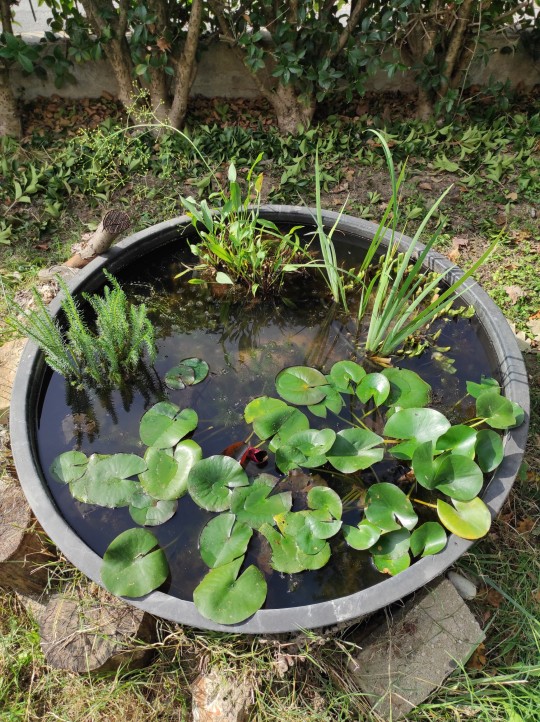
Before starting the real autumn work, I needed to clean it up. So this was like, prepping it for the actual makeover of the next weeks.
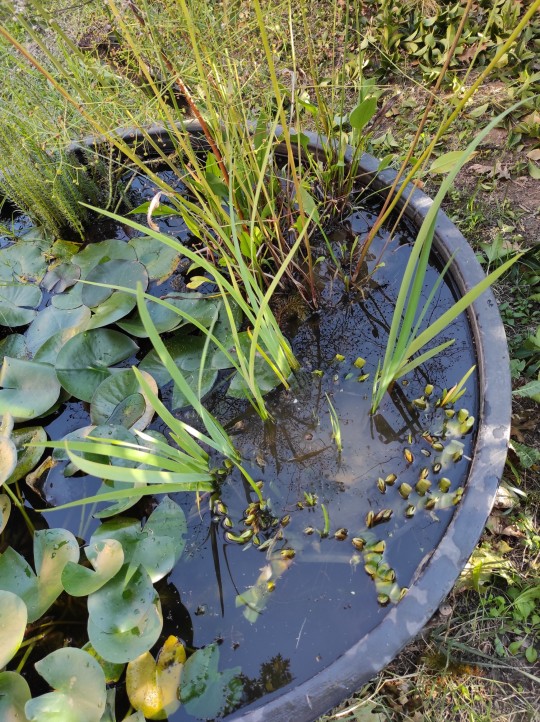


First it was the Iris, because it has more easily cuttable leaves. There were so many I had to make it in two times. Btw that vase had once a square shape, and if you enlarge the picture you can clearly see it's not longer the case, lol. I only left the younger leaves marking the plants for the repotting (not really necessary), and given how big the plant became without producing a single flower, I'm giving it until next June (even if they actually bloom in May) and then if nothing happens we'll say goodbye, because it means it isn't working between us.

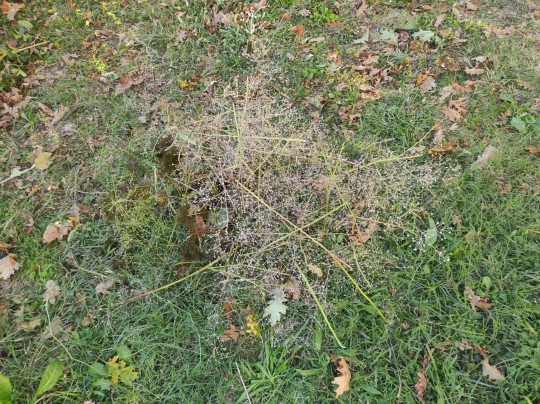
Without the other leaves I could work on the water plantain and its branches, which was the most difficult thing, even if it doesn't show on photos, because they're massive and rigid and most importantly ALL TANGLED TOGETHER in one airy undetachable mess. I left only two little branches that had still to bloom bc I felt guilty cutting them too (although one doesn't stay up alone so it awkwardly dangles backwards and outside). I have also to say I'm very pleased to see that it hasn't dried up and died! There are a lot of new little leaves, I'm very glad to see it recovered from whatever happened this summer.


The mare's tail only needed some pruning for the dried parts (since I've done the resizing already). Glad to see it's in good shape and still trying to escape the pot, but I won't be fooled anymore! Biggest surprise and success is the canadian waterweed reaching surface level!!!! Never ever happened until now! Rejoice! Fingers crossed that next year it'll even make some flowers!
I'm very satisfied with the result and super excited for the next steps! Until next time, I wish y'all a happy autumn equinox and a lovely sunday :)
#the pondsy chronicles#water lily#nymphaea#ninfea#iris#iris louisiana#common water plantain#alisma plantago aquatica#mestolaccia#common mare's tail#hippuris vulgaris#coda di cavallo acquatica#hornwort#coontails#ceratophyllum demersum#ceratofillo comune#canadian waterweed#elodea canadensis#elodea canadese#mini pond
6 notes
·
View notes